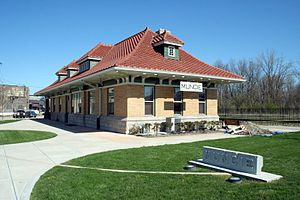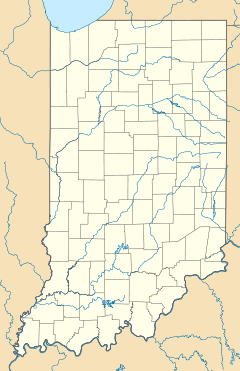- Cincinnati, Richmond, & Muncie Depot
-
Wysor Street Depot 
The depot as seen in 2007Station statistics Address 700 E. Wysor St.
Muncie, IndianaOther information Opened 1901 Closed 1986 Rebuilt 2004
Cincinnati, Richmond, & Muncie DepotCoordinates: 40°11′51″N 85°22′45″W / 40.1976°N 85.3791°WCoordinates: 40°11′51″N 85°22′45″W / 40.1976°N 85.3791°W Architect: William S. Kaufman; Locke & Hill Architectural style: Romanesque Governing body: Private NRHP Reference#: 97000304 Added to NRHP: April 14, 1997[1] The Cincinnati, Richmond & Muncie Depot (also known as the Wysor Street Depot) is a restored train station in Muncie, Indiana, United States. It was originally built in 1901 and was acquired by the Chesapeake and Ohio Railway in 1910. The station was used for passenger train service throughout the 20th century and was added to the National Register of Historic Places in 1997. It is currently used as a visitor center and office space for the adjacent Cardinal Greenway.
History
The station was originally built by the Cincinnati, Richmond and Muncie Railroad (CR&M) in 1901. The Chesapeake and Ohio Railway (C&O) acquired the CR&M in 1910. C&O discontinued passenger service to Muncie in 1949, but the station remained in use for freight service until 1950 when the Muncie Gear Works became its new tenant. In 1973, Chessie System (which eventually became CSX Transportation) returned the station to active passenger service so it could be used by Amtrak on the James Whitcomb Riley and George Washington routes (which eventually became the Cardinal). The station again was removed from passenger service when the Cardinal was rerouted in 1986.[2] The station was listed on the National Register of Historic Places on 1997-04-14.[1] Restoration of the station began in 2003.[3] The restoration was completed and the building reopened to the public on 2005-06-05.[4]
The building is now used as a visitor center and office for the Cardinal Greenway recreation trail (a trail which uses the former C&O right-of-way). On display inside are photos and artifacts from the region's railroad history as well as photographs of the surrounding communities. Although the former C&O track has since been removed, a second parallel track, now owned by the Norfolk Southern Railway, remains in operation; it is separated from the Cardinal Greenway trail by a fence to ensure visitors' safety.
References
- ^ a b "National Register Information System". National Register of Historic Places. National Park Service. 2009-03-13. http://nrhp.focus.nps.gov/natreg/docs/All_Data.html.
- ^ Giese, Michael (2002). "Wysor Street Depot History". Cardinal Greenway. Archived from the original on 2007-08-09. http://web.archive.org/web/20070809024758/http://www.delgreenways.org/History/depot_story.htm. Retrieved 2007-04-28.
- ^ "Depot restoration". Cardinal Greenway. 2002. Archived from the original on 2007-04-05. http://web.archive.org/web/20070405173416/http://www.delgreenways.org/Construction/Depot/index.htm. Retrieved 2007-04-28.
- ^ "Cardinal Greenway". Indiana Trails.org. http://www.indianatrails.org/Cardinal_Greenway_Muncie.htm. Retrieved 2007-04-28.
Categories:- Railway stations opened in 1901
- Railway stations closed in 1986
- Muncie, Indiana
- Stations along Chesapeake and Ohio Railway lines
- Railway stations on the National Register of Historic Places in Indiana
- Former Amtrak stations in Indiana
- National Register of Historic Places in Muncie, Indiana
- Visitor attractions in Delaware County, Indiana
Wikimedia Foundation. 2010.

